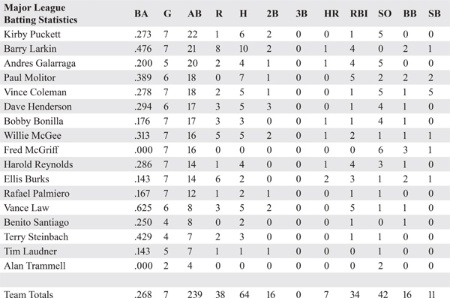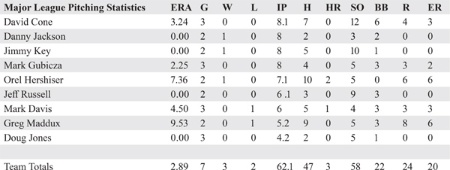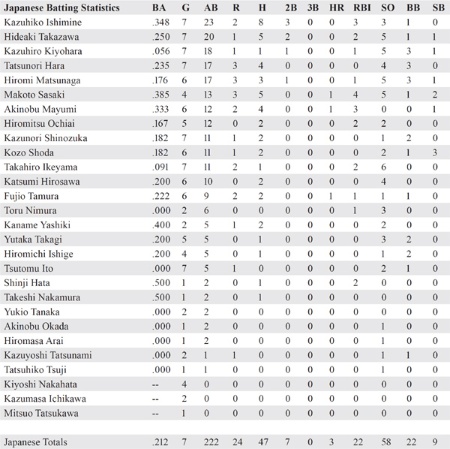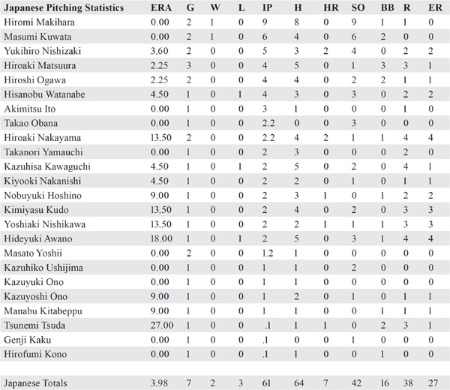The 1988 Major League-Japan All-Star Series
This article was written by Chris Hicks
This article was published in Nichibei Yakyu: US Tours of Japan, 1960-2019
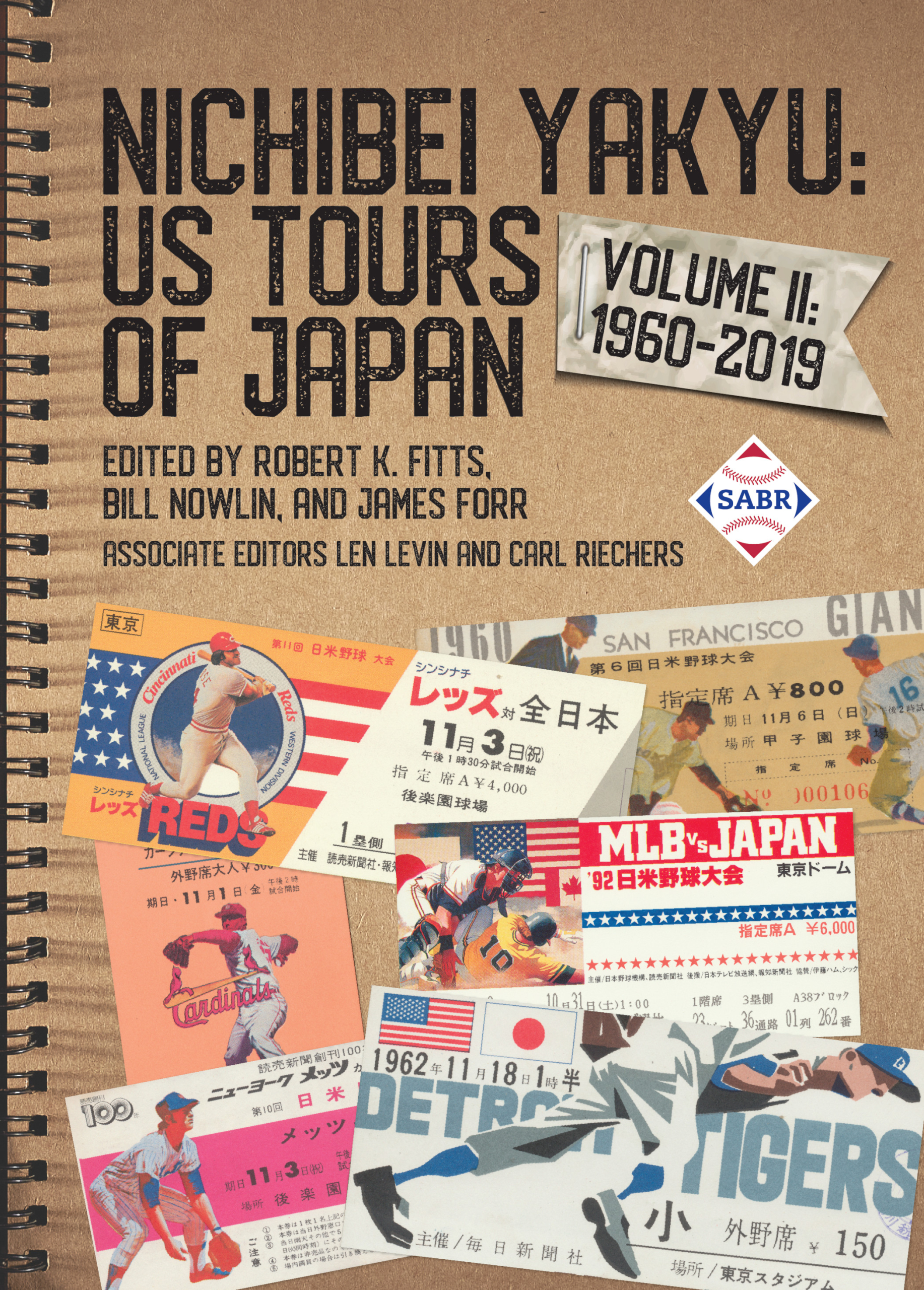 The 1988 Major League-Japan All-Star Series was the 24th time that major leaguers had gone on a goodwill tour of Japan. Although many independent tours had happened over decades, the semiannual Japan All-Star Series had only begun in 1986. On that tour, the major-league All-Stars won the series six games to one. Gearing up for the seven-game 1988 event, the American press, public, and those involved in professional baseball all expected a similar performance.1
The 1988 Major League-Japan All-Star Series was the 24th time that major leaguers had gone on a goodwill tour of Japan. Although many independent tours had happened over decades, the semiannual Japan All-Star Series had only begun in 1986. On that tour, the major-league All-Stars won the series six games to one. Gearing up for the seven-game 1988 event, the American press, public, and those involved in professional baseball all expected a similar performance.1
Future Hall of Fame manager Sparky Anderson of the Detroit Tigers managed the US team, called the M.L. All-Stars, along with coaches Roger Craig of the San Francisco Giants and Alex Grammas of the Tigers. Anderson had previously managed the Cincinnati Reds in a tour of Japan in 1979, winning the series 14 to 2 with 1 tie. During a workout in Los Angeles on November 1, Anderson announced his goal for the team: winning all seven games. However, he also knew a sweep of the series would not be easy, acknowledging that the Japanese had much improved since the last time he was there. “If we don’t go and play them hard, they can beat us,” Anderson warned. He declared that the outcome would be determined mostly by the effort of the M.L. squad. Anderson added that the social aspect was what the players would remember for the rest of their lives. He spoke of reciprocal respect between the Japanese and American players, ensuring that “the players will never enjoy anything more than their 12 days in Japan.”2
The Major League Baseball Players Association and the commissioner’s office worked together to carefully assemble a squad of players. None of the players on the 1986 squad were chosen for this iteration of the tour. In contrast to the older players who toured Japan in 1986, the 1988 team was almost entirely a group of young stars and players who were just coming into their own, including Benito Santiago of the San Diego Padres, Willie McGee of the St. Louis Cardinals, Fred McGriff of the Toronto Blue Jays, and David Cone of the New York Mets. Five of the chosen players were later enshrined in the Hall of Fame: Greg Maddux of the Chicago Cubs, Paul Molitor of the Milwaukee Brewers, Alan Trammell of the Tigers, Barry Larkin of the Reds, and Kirby Puckett of the Minnesota Twins. Puckett commented, “You couldn’t put a better one together.”3 Six of the hitters had batting averages of .300 or above and five had more than 24 home runs. The pitching staff was also strong, including four 20-game-winners, all Cy Young Award contenders.4
The players were selected not only for their talent, but also for “their diplomatic skill.”5 At this point, Japan had emerged as an economic superpower, contending with the United States. Japan invested heavily in American industries and real estate. The popularity of Japanese products with American consumers resulted in a sizable trade deficit and threatened American manufacturing jobs, which led to resentment and anti-Japanese rhetoric. Politicians capitalized on the discontent of many Americans whose livelihoods were threatened by the shift in the economy during the 1980s. These leaders fanned anti-Japanese sentiment further. Lawmakers were even photographed destroying imported Japanese products with sledgehammers on the Capitol Hill lawn.6
At the same time, Congress passed major legislation benefiting the Japanese American community by a veto-proof majority. The Civil Liberties Act of 1988 was passed to address actions toward Japanese Americans in World War II. The measure acknowledged the injustice of placing Japanese Americans in internment camps, and provided reparation payment to them. It served as a formal apology and signified the intent to award those who had suffered internment a $20,000 tax-free disbursement. These reparation payments only later came to fruition, though. The funding that had been allocated for them disappeared before the payments were made. The next year’s austerity budget reduced or eliminated funding for many programs. Ironically, the Japanese government supported the American budget cuts, demanding continued financial austerity when it agreed to stabilize the US dollar in December 1988.7
During the 1988 season, Los Angeles Dodger Orel Hershiser’s scoreless streak was one of the top news stories. On September 28 Hershiser pitched 10 innings, extending his run to 59 scoreless innings and breaking Dodgers Hall of Famer Don Drysdale’s record of 58⅔ innings set in 1968. Drysdale, who was a broadcaster for the Dodgers, was in attendance. On the heels of Hershiser’s achievement, the Dodgers went into the playoffs, ending up in the World Series against the Oakland A’s. Hershiser’s Dodgers won the Series in five games; Hershiser was named the Series’ Most Valuable Player.
During the 12-day stretch between the World Series and the start of the Japan tour, coverage of Hershiser dominated the sports pages. He originally declined to participate in the tour.8 However, his contract with the Dodgers expired at the end of the 1988 season, and he agreed to go on the tour, possibly hoping his performance would have a beneficial effect on his salary negotiations. He said he wanted to stay with the Dodgers, but was open to the possibility of playing in Japan in 1990, when he could change teams.9 The record-breaking streak was alive, and many expected him to lengthen it with more innings in the following season. In early 1989, Hershiser was able to leverage all of these factors to sign a record-breaking three-year contract worth $7.9 million with the Dodgers.10
The US All-Star team gathered for a workout in Los Angeles on November 1. Their flight left the next day, giving the players time to get acclimated to their surroundings.11 Although they could recover from the long flight before taking the field, they didn’t have the same opportunity to rest before playing their roles as ambassadors. It was a two-hour drive from the airport to their hotel, but mere minutes after arriving, the players had to appear at a press conference at the hotel.
The Japanese public treated manager Anderson “with the reverence accorded a Zen master.”12 Japanese baseball fans were very welcoming, latching onto such stars as Hershiser and future Hall of Famer Puckett. Based on his physique, Puckett was likened to a Sumo wrestler; Hershiser was acclaimed for his historic performance on the mound in 1988. One Japanese reporter said of Puckett, “We have never seen anyone like him before.” An American reporter responded: “Neither have we.”13
The media did not disappoint its public by focusing coverage on these players. Hershiser, tapped to start the series opener, expressed concern about being at a disadvantage facing new batters. Still, Hershiser asserted that his “competitive juices will be flowing.”14 Puckett was also eager to get on the field in Japan, saying, “I’ve been off for almost a month, and I’ve got the itch to play again.”15 That evening, a banquet was held for the two teams. Hershiser was seen showing Japanese pitchers how he gripped different pitches. The American press referred to his demonstrations when they discussed Hershiser’s performance during the series.16
On November 5 the series began at the Tokyo Dome, the only domed stadium in Japan. The dome was at capacity, with 56,000 in attendance.17 In a broadcast first, ESPN aired the game live starting at 11:30 P.M. ET. The announcers ESPN used for this game and one other in the series were Baltimore Orioles broadcaster Jon Miller and future Hall of Famer Don Sutton, who had just retired after 23 years as a major-league pitcher.18
The Japanese All-Stars won the first game, 2-1. In the fifth inning Seattle Mariner Harold Reynolds drove in Willie McGee for the only M.L. run.19 The score was tied, 1-1, until the bottom of the ninth, when Japanese designated hitter Kazuhiko Ishimine of the Hankyu Braves hit a walk-off RBI single, known in Japan as a “sayonara hit,” on a pitch from San Diego Padres pitcher Mark Davis. This first game was an adjustment for the Americans. Not only had they not faced the Japanese pitchers before, but the crowds were different. They were largely silent until cheerleaders led them in “loud and monotonous” cheers.20
The second game of the series, on November 6, was also played at the Tokyo Dome, again before a sellout crowd of 56,000. The major leaguers went out to an early lead on a solo home runs by Cincinnati’s Barry Larkin and Ellis Burks of the Boston Red Sox. They added a third run in fifth inning as pinch-runner Vince Coleman stole second and third and scored on a wild throw by catcher Tsutomu Ito. In the fifth the Japanese tied the score on an error, a walk and three hits but the visitors retook the lead in seventh as Molitor singled in Burks.
In the bottom of the seventh with one out, Hiromi Matsunaga and Akinobu Mayumi singled off David Cone. With runners at the corners, Shinji Hata grounded to second. Second baseman Vance Law attempted to tag Mayumi as he ran towards second, but Mayumi swerved out of the baseline to avoid the tag. Law then threw to first to retire Hatta as Matsunaga crossed the plate. The umpire ruled Mayumi safe a second and allowed the run. Anderson charged on to the field to protest and “a heated argument ensured,” but the call stood and the game was tied, 4-4.21
In the top of the ninth, after Molitor had knocked in Dave Henderson to give the major leaguers a 5-4 lead, reliever Genji Kaku of the Chunichi Dragons came in with Vince Coleman on first and Willie McGee on third. American umpire Jim Evans then called a balk, a rule that was rarely enforced in Japan, on Kaku allowing McGee to score. After the game Kaku complained, “How can they call a balk when we don’t even know what they are?”22
Down 6-4 in the bottom of the ninth, Matsunaga, Mayumi, and Hiromitsu Ochiai each singled off Cone to narrow the score to 6-5. Anderson brought in Doug Jones to close the game but Hideaki Takazawa greeted him with a double to tie the score. Jones then intentionally walked Yutaka Takagi to load the bases with one out before striking out slugger Kazuhiro Kiyohara and inducing Katsumi Hirosawa to ground out to third. As the teams had agreed not to play extra innings during the series, the game ended in a 6-6 tie.
On November 8, Game 3 was played at Heiwadai Stadium in Fukuoka, where 32,000 fans saw the American bats come alive.23 The Americans topped the Japanese All-Stars 16-8. Willie McGee, Ellis Burks, Harold Reynolds, and Bobby Bonilla all hit home runs.24 Makoto Sasaki of the Nankai Hawks had three RBIs for the Japanese squad. He hit a home run off Orel Hershiser, who pitched in relief of Greg Maddux.25 During the game, the Americans had a guest in their dugout, Yasokichi “Sally” Konishiki.26 The 530-plus-pound Sumo wrestler from Hawaii was the heaviest Sumo competitor in history at that point.27 The players were fascinated by the hulking figure of Konishiki as he signed autographs for them.28
The Americans celebrated their first victory by joking around with the fans. Greg Maddux, for example, had a 10,000-yen note attached to a string and dangled it in front of fans. In 1988, the bill was worth US $81. Roger Craig faked throwing his cowboy hat to the crowd, and Rafael Palmeiro threw an empty baseball box into the stands. The fans, who were eager to see the American team, relished the attention.29
Hershiser had to leave the tour unexpectedly after the game. He returned home to California to be with his sick son. The two-month-old boy, Jordan, had been born with fluid in his lungs, making even a cold a serious condition. Hershiser had struggled mightily in this series, exiting with a 7.37 ERA, the polar opposite of the stats he turned in during the 1988 season.30 Despite this performance, the focus of the tour remained the interaction with the Japanese. Reflecting on his experience in Japan, Hershiser said the media and fans treated him “like … a rock star.”31
Game 4 took place on November 9 in Osaka’s Koshien Stadium. The crowd of 30,000 saw the Americans win their second game in a row, 8-2. Andres Galarraga of the Montreal Expos had three RBIs while Jimmy Key of the Toronto Blue Jays gave up just two hits with six strikeouts in five innings of work. The Japanese got their runs from a seventh-inning homer by the Hanshin Tigers’ Akinobu Mayumi off Mark Davis. Doug Jones of the Cleveland Indians closed out the game with three strikeouts in the final two innings.32
Game 5 saw a return to the Tokyo area on November 10 when 23,000 fans went to see the contest at Seibu Stadium in Tokorozawa. The Americans took their third in a row, 3-1. Cincinnati’s Danny Jackson, the New York Mets’ David Cone, and Kansas City’s Mark Gubicza combined to give up just three hits and strike out nine. Rafael Palmiero of the Cubs, Vince Coleman of the Cardinals, and Tim Laudner of the Twins had doubles; Coleman also had a stolen base.33
Also on November 10, the Cy Young Awards were also announced. Jackson and Cone finished second and third, respectively, in the National League vote and Gubicza finished third in the American League. The three men celebrated that night. Gubicza told reporters, “We were commenting on how nice it would have been if we could have been on the same staff together, but it turned out just great for all of us. We all had dream seasons.”34 The three pitchers had all been on the Kansas City Royals’ staff in 1986.35
In Game 6, on November 12, a sellout crowd watched as the Japanese squashed any ideas of a continued US winning streak. The Nippon team came back to win its second game, 5-4, behind the efforts of the Nankai Hawks’ Makoto Sasaki, who had two hits, two runs, and an RBI. Barry Larkin was the star for the Americans with two doubles and two RBIs.36 Greg Maddux, working in relief with a 3-0 lead, gave up five runs, six hits, two walks, and a wild pitch in a little over two innings; the result was four runs for the Japanese.37 In the field, first baseman Rafael Palmeiro had an error as a ball went under his glove and rolled to the left-field wall during Japan’s decisive seventh-inning rally.38 Hiromi Makihara of the Yomiuri Giants gained the win, pitching four scoreless innings and striking out Dave Henderson with a split-fingered fastball that American pitching coach Roger Craig had just taught him.39 This was the second and last game of the series that ESPN showed live.40 The games the cable network aired were the only two the M.L. All-Stars lost, showing their worst performances to the American television audience.
The seventh and final game of the series was played on November 13 before a sold-out crowd at the Tokyo Dome. Vince Coleman had a solid day with three singles. Overall the game saw a lack of offense. It finished in a 0-0 tie after nine innings, again because of the series’ no-extra-inning rule. The Americans had a chance to score in the first after Coleman and Paul Molitor led off with singles, but Masumi Kuwata of the Yomiuri Giants retired Puckett on a groundball and struck out Fred McGriff and Bobby Bonilla. Mark Gubicza, David Cone, and Doug Jones allowed only three hits while striking out seven Japanese hitters.41
The major-league All-Stars won the series 3 games to 2 with 2 ties. The outstanding players of the series were Barry Larkin and Hiromi Makihara. Larkin hit .476 (10-for-21). Yomiuri Giants pitcher Makihara had nine strikeouts in nine innings and a Game 6 victory under his belt.42
Sparky Anderson said, “The Japanese should stop comparing themselves to Americans. They are good baseball players, period. They should stand on their own.”43 Hershiser commented, “Their pitching is real strong. I think it’s the closest thing they have to the big leagues.”44 Excuses abounded for why the major leaguers had not performed more strongly against the Japanese, whose talent was seen as far inferior to that of the Americans. According to Steve Wulf of Sports Illustrated, they included, “They weren’t in shape; they didn’t take the series seriously; they were playing under foreign circumstances.” To support the criticism that the major-league team was not taking the games seriously, Wulf pointed to the two teams’ behavior during batting practice. The Japanese were seen as taking a very serious approach, focusing on the game. In contrast, the Americans seemed to be overconfident, throwing around a football on the field instead of maximizing the practice.45
Wulf broached the idea of a US vs. Japan world series. Sparky Anderson praised the Japanese, commenting that pitcher Hiromi Makihara “would make any pitching staff in baseball.” Makihara, asked if he would like to play baseball in America, said, “If that is possible, I’d like to.” Anderson also liked the idea of eventually having a US vs Japan world series, but said it would take time for the Japanese talent levels to rise to the level of the Americans. Toru Shoriki, owner of the Yomiuri Giants, agreed. “Having a real world series between Japan and the US has been my lifelong dream,” he said. “We are still a long way away, but as this tour has shown, we are progressing.”46 Though the Americans still won the series, the fact that the Japanese came within one game of winning for the first time could be considered a moral victory.
CHRIS HICKS began watching baseball with his grandfather as a child, which led to a lifelong passion for the game and his local Kansas City Royals. A wheelchair user since childhood, Chris became interested in the history of the game and the baseball card collecting hobby. His uncle took him to a Monarchs reunion in the early 1990s. This began years of learning independently about the history of the game. He joined SABR in 2020.
(Click images to enlarge)
Notes
1 Associated Press, “Sparky Seeks Sweep for Stars in Japan,” Port Huron (Michigan) Times-Herald, November 2, 1988: 5B.
2 Associated Press, “Sparky Seeks Sweep for Stars in Japan,” Salisbury (Maryland) Daily Times, November 2, 1988: 20.
3 Associated Press, “Sparky Seeks Sweep for Stars in Japan.”
4 Associated Press, “Sparky Seeks Sweep for Stars in Japan.”
5 Steve Wulf: “Where Orel Got Hit,” Sports Illustrated, November 21, 1988: 38.
6 Adam Thierer, “‘Japan, Inc.’ and Other Tales of Industrial Apocalypse,” Discourse Magazine, June 28, 2021. https://www.discoursemagazine.com/culture-and-society/2021/06/28/japan-inc-and-other-tales-of-industrial-policy-apocalypse/.
7 Rowland Evans and Robert Novak, “Backstage on the Budget,” Washington Post, December 19, 1988. https://www.washingtonpost.com/archive/opinions/1988/12/19/backstage-on-the-budget/f4cb343d-cd63-487a-be4c-e4d05bff6621.
8 Wulf: 38.
9 Associated Press, “Hershiser Price Tag $3 Million?” Palm Springs (California) Desert Sun, November 2, 1988: C1.
10 Gregg Patton, “Hershiser in Right Place, Right Time,” San Bernardino County Sun, (San Bernardino, California), February 17, 1989: C1.
11 Associated Press, “Sparky Seeks Sweep for Stars in Japan,” 5B.
12 Wulf: 38.
13 Wulf: 38.
14 Associated Press, “Sparky Seeks Sweep for Stars in Japan.”
15 Associated Press, “Sparky Seeks Sweep for Stars in Japan.”
16 Wulf: 41.
17 “Yesterday’s Box Score Japanese All-Stars, 2-1 at Tokyo,” Boston Globe, November 6, 1988: 83.
18 Prentis Rogers, “ABC Pulls Plug on WSB’s Marathon Coverage Plans,” Atlanta Constitution, November 4, 1988: 2E.
19 “Yesterday’s Box Score Japanese All-Stars, 2-1 at Tokyo.”
20 Fred Hiatt (Associated Press), “Baseball Fortunes on the Rise in the Land of the Rising Sun,” Fort Myers (Florida) News-Press, November 30, 1988: 9C.
21 Rob Smaal, “Japan Ties U.S. Squad in 9th,” Japan Times, November 7, 1988: 10.
22 Wulf: 41.
23 Wulf: 41.
24 “Major League Stars Pound Japanese,” Wausau (Wisconsin) Daily Herald, November 8, 1988: 1B.
25 United Press International, “Home Run Happy U.S. All-Stars Blast Japanese Stars, 16-8,” St. George (Utah) Daily Spectrum, November 9, 1988: B2.
26 Wulf: 41.
27 “The Winner Deserves the 10,000 Rice Cakes,” Los Angeles Times, January 26, 1988: III, 2.
28 Wulf: 38.
29 Wulf: 38.
30 Wulf: 41.
31 Associated Press, “Surprise! Orel Is Unanimous,” Belleville (Illinois) News-Democrat, November 11, 1988: 1D, 4D.
32 “Pirates Trade Player in Deal with Orioles,” Belleville News-Democrat, November 10, 1988: 5D.
33 “Baseball U.S. vs Japan,” Reno Gazette-Journal, November 11, 1988: 6B.
34 Bob Nightengale, “Gubicza Is Unanimous Pick for Royals’ Pitcher of the Year,” Kansas City Times, November 19, 1988: B-4.
35 “1986 Kansas City Royals Statistics,” Baseball-Reference.com. https://www.baseball-reference.com/teams/KCR/1986.shtml.
36 Associated Press, “Japan All-Stars Win 5-4 Over Big Leaguers,” Berkshire Eagle (Pittsfield, Massachusetts), November 13, 1988: B10.
37 “Baseball Exhibition Tour,” Boston Globe, November 13, 1988: 84.
38 Hiatt.
39 Wulf: 41.
40 Rogers, “ABC Pulls Plug on WSB’s Marathon Coverage Plans.”
41 Associated Press, “U.S., Japan Conclude Baseball Series with 0-0 Tie,” Lafayette (Indiana) Journal and Courier, November 14, 1988: B3.
42 Associated Press, “U.S., Japan Conclude Baseball Series with 0-0 Tie.”
43 Wulf: 41.
44 Hiatt.
45 Hiatt.
46 Wulf: 41.
47 These tables include all participants in the series. Yoshikazu Matsubayashi, Baseball Game History: Japan vs, U.S.A. (Tokyo: Baseball Magazine, 2004), 106; Nippon Professional Baseball Records, https://www.2689web.com/nb.html; Wayne Graczyk, 1989 Japan Pro Baseball Fan Handbook & Media Guide (Tokyo: Fan Te-cho, 1989), 46-49.



